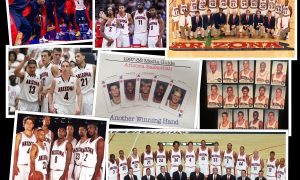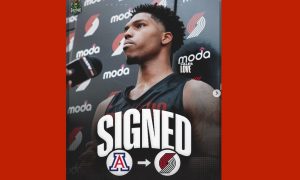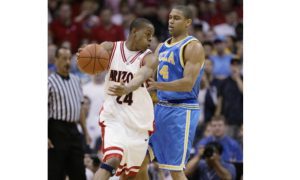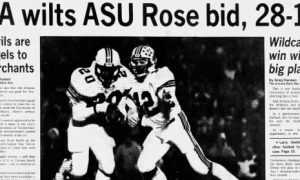|
|
|
ARIZONA PRODUCTIVITY RATING
[table “” not found /]
GLOSSARY:
G: Games played. S: Number of starts.
BP: Bench points. A player gets three points if he is first off the bench, two if second and one if third. Shows Sean Miller’s rotation.
USC: Productivity points against USC
UMIN: Minutes played against USC
PP: Productivity Points (Points, assists, rebounds, steals, blocked shots, FGs made, FTs made added together and then subtracted by missed FGs, missed FTs, personal fouls and turnovers)
TMIN: Minutes played overall
PR: Productivity rating per minute played (Productivity points divided by minutes played)
NOTE: Player must average at least 10 minutes a game to be listed in primary rotation
|
PAC-12 STANDINGS [table “” not found /] |
This was not a case of looking ahead, although Arizona is now 6-9 against USC in Los Angeles before it prepares for rival UCLA since Lute Olson was hired in 1983-84. Sean Miller is now 0-3 in his four years with the Wildcats when the UA plays the Trojans first on this road trip. The Wildcats have been in this trap situation before, most notably in their championship season of 1996-97 and when they were ranked No. 1 late in the following season of 1997-98. Arizona lost at USC each of those years before before playing UCLA in Pauley Pavilion. Although USC traditionally is less of an opponent than UCLA — including this season — the Wildcats can blame their inexplicable 89-78 loss last night to defensive breakdowns. One snapshot of the game was Nick Johnson losing his footing while trying to guard Jio Fontan, who took advantage of the open space and drained a three-pointer in the second half. |
“Our perimeter defense was poor at best,” Miller told Brian Jeffries in the Wildcat Sports Network radio post-game show.
“It was our worst defensive performance of the year and it couldn’t have come at a worse time.”
If Arizona was unable to focus and heed to Miller’s demands because of the upcoming rematch against the Bruins with ESPN’s College GameDay at Pauley Pavilion, than the Wildcats are in disrepair because a Pac-12 title is at stake with two weeks left. Listening to Miller’s tone of voice with Jeffries, the Wildcats’ coaches may not be in panic mode, but they are concerned.
The Wildcats won 12 games without a loss in the non-conference portion of the schedule, which will get them a favorable seed in the NCAA tournament. But they have struggled against top competition in the Pac-12 and have yet to win 12 games in the conference through 16 games.
The Wildcats are 3-5 against Pac-12 teams with winning conference records and one of those wins against Colorado at McKale Center was by a fraction of a second. Sabatino Chen’s potential game-winner at the buzzer was ruled to be a fraction of a second too late.
USC, which has better talent than its 13-15 record indicates, shot 61.1 percent from the field, including 65.2 percent in the second half. Nobody could guard Trojans forward Eric Wise, who made 9-of-12 shots from the field and finished with a season-high 22 points. The Wildcats have allowed career- and season-high totals to Wise, Chen and Colorado’s Xavier Johnson this season.
Cal’s Allen Crabbe scored 31 points against Arizona, his highest output in a Pac-12 game this season.
Solomon Hill ironically had one of his better games defensively with five steals against the Trojans. Hill and Kevin Parrom played mostly as seniors should — combining for 53 productivity points in 65 minutes — but the rest of the Wildcats had 48 productivity points.
The Wildcats are built on balance. They need more than two players to perform in order for them to win. Arizona’s starting backcourt of Mark Lyons and Nick Johnson can be one of the nation’s best, but they must play more consistent on both ends of the floor.
Johnson’s struggles in the Pac-12 mirrors Arizona’s decline following its 12-0 non-conference start. He has a .496 productivity rating in Pac-12 games after posting a .682 mark in the non-conference schedule.
His defense on the perimeter sets the tone for the Wildcats. He played only 23 minutes against USC and sat on the bench late in the game when Arizona tried to get back in the game.
Bruce Pascoe of The Arizona Daily Star asked Miller about Johnson’s recent shortcomings after the loss to USC.
“We’re going to work hard to get Nick back playing well,” Miller told Pascoe, who then asked if Johnson is carrying too much of a burden as the top defender and having to shoot well and score on the other end.
“I don’t know. One thing we can do to help his fatigue is not play him as much.”
The Wildcats were also out-rebounded by USC 34-29, the most they have been out-rebounded since Dec. 15 when Florida won the battle of the boards 33-22. The Trojans’ 29 defensive rebounds equaled Arizona’s overall total. That means the Wildcats struggled with many one-shot possessions en route to a 40 percent performance from the floor.
Just a bad night all around. The Wildcats have two days to prepare for UCLA, rather than only one as was the case in past conference schedules. That added time can only help.
Arizona is also 6-1 in the second game of the conference’s weekly schedule this season, but five of those wins were against the bottom teams in the conference — Utah, Washington State and Oregon State.
Defensive Rebounding Percentage (DRB%): Determined by dividing Arizona’s defensive rebounds (18 against USC) by the opposition’s offensive rebounds (USC had only five mostly because of its hot shooting) added to Arizona’s defensive rebounds (18) — 18/(5 + 18) = 78.2 percent.
Offensive Rebounding Percentage (ORB%): Determined by taking Arizona’s offensive rebound total (11) divided by that total (11) and the defensive rebounds of the opponent (29 for USC) — 11/(11 + 29) = 27.5 percent.
Ideal marks are 72 percent DRB% and 38 percent ORB%.
|
DEFENSIVE/OFFENSIVE REBOUNDING% [table “” not found /] |
Site publisher, writer and editor Javier Morales is a former Arizona Press Club award winner
[rps-paypal]
|
|






























